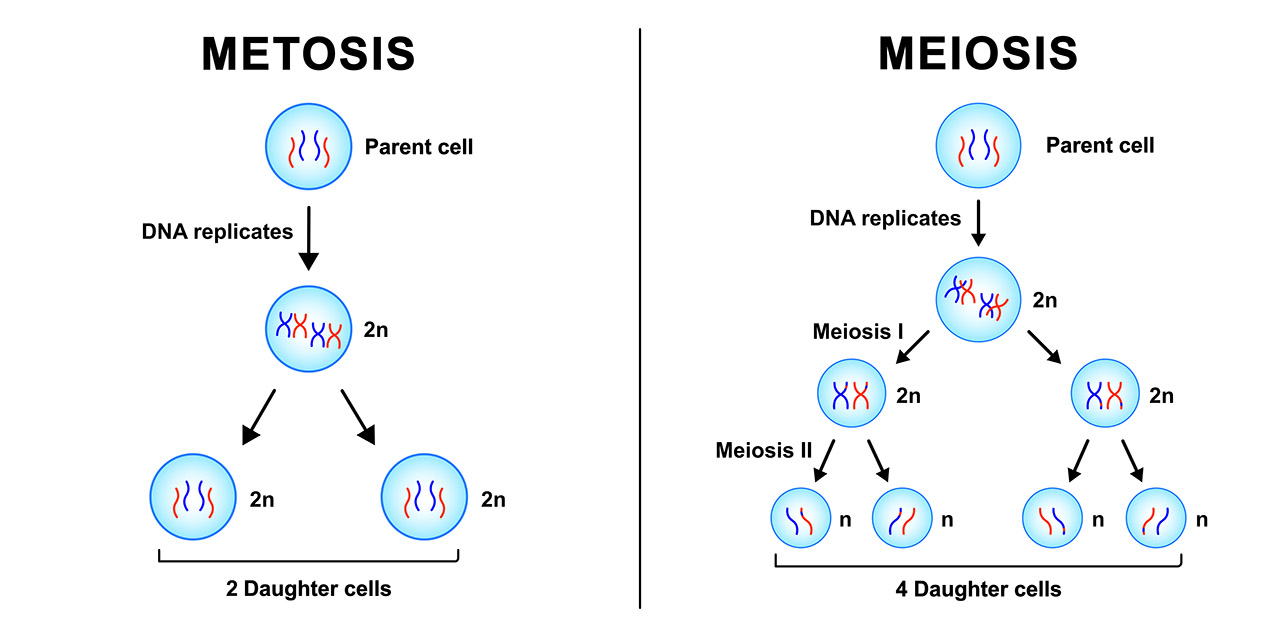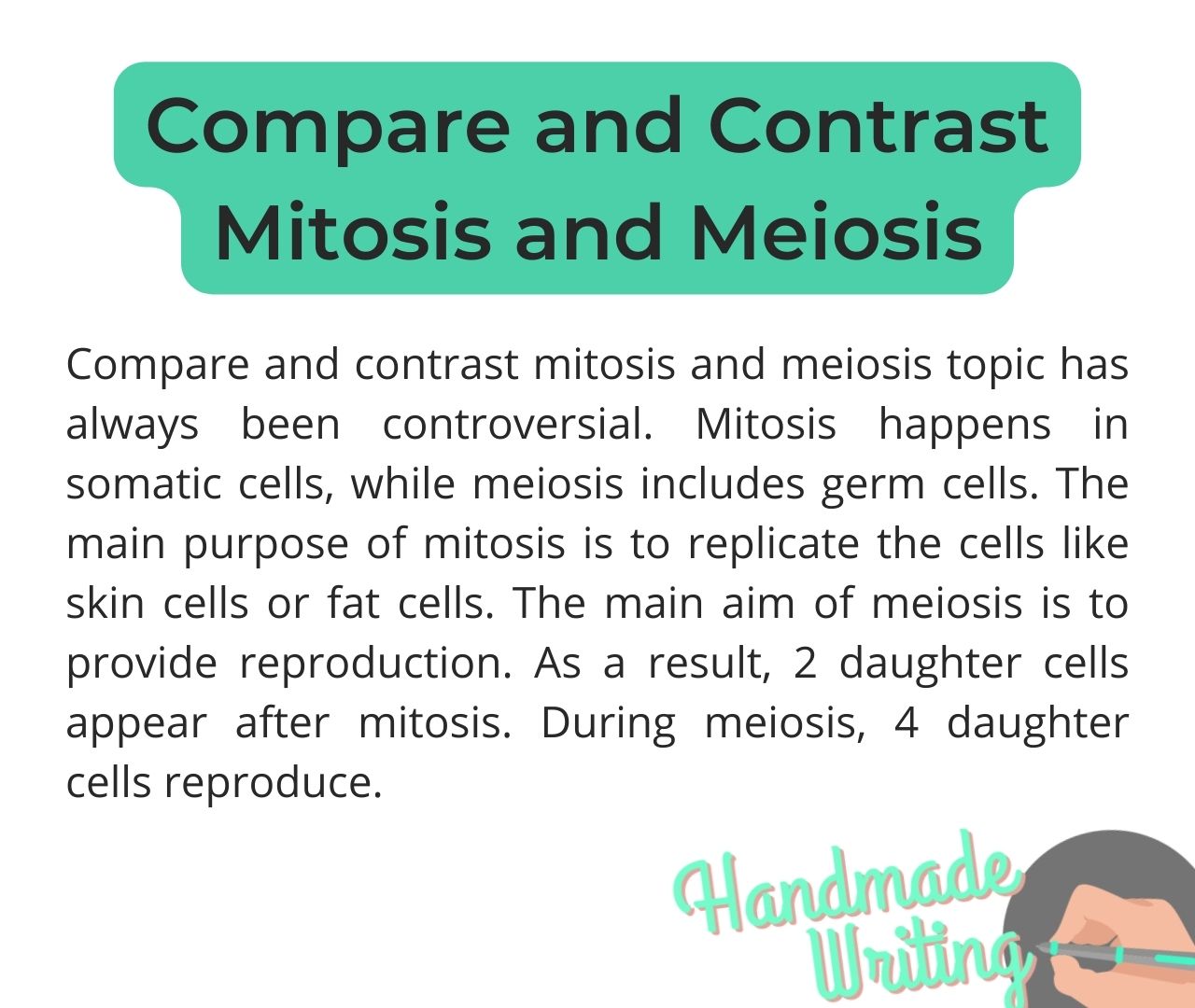This Essay sample was written by Handmadewriting Team
The continuation of generations and the growth thereof of organism utilizes the process of cell division, especially in eukaryotic cells where this process takes the form of either mitosis or meiosis. The two types of cell division have been shown to be as similar as they are distinct especially on the source of the chromosomes. Mitosis, in this respect, involves duplication of DNA of a cell, that is then shared equally between two identical cells. The mother cell undergoes the cell cycle, which is a structured series of events, following signals or growth factors in the organism. Many somatic cells in the body such as skin cells and the fat cells undergo this replication in replenishing the organs. Meiosis, on the other hand, is common in gametes where organisms reproduce sexually. Both the male and the female gonads produce sex cells, with each cell having half-chromosomal constituent for the new cell. However, meiosis involves gene recombination, and the resultant four cells are genetically unidentical.

Both mitosis and meiosis represent cell division where the chromosomal constituents of cells are replicated. There are an almost identical division and transportation of chromosomes to the newly formed cell, with several of the steps involved bearing resemblance significantly. Mitosis makes use of cytokinesis that initiates cleavage, and the resultant daughter cells are identical (Oliferenko, Chew, & Balasubramanian, 2009). From this type of cell division, cells are able to repair and grow with cancer being an abnormality of the accelerated mitosis. Meiosis, on the other hand, comprises of two divisions taking place separately and the chromosomes are reduced by half. The key difference is, whereas mitosis produces two diploid cells, the two cells produced in meiosis are haploid in nature, containing one of each pair of chromosomes. These cells are, usually, involved in syngamy.
Even in the glaring differences of the two processes, the two types of cell division and replication involve multiple-stage processes. These are mainly interphase, prophase, metaphase, anaphase and lastly, telophase. Similarly, identical processes take place in each of those mentioned stages such as the preparation of the cells’ DNA for the division in interphase. Duplication of the DNA content then follows in both the type of division where each strand chromosomes undergoes replication, and two sister chromatids are formed (Fu, Hagan, & Glover, 2015). During the replication process, two centrosomes move to opposite sides of a cell, with microtubules form a path for the motor proteins of chromosomes to follow as they pull and separate towards the newly formed cells and this occurs in both mitosis and meiosis.
Again, there is a comparable degradation of the nucleus and the eventual rebuilding in the newly formed sister cells. The nuclear membrane undergoes degradation and reformation where chromosomes align at the cell’s center, followed by an even splitting in two directions. The reforming of nuclear membranes occurs in anaphase (Schellhaus, De Magistris, & Antonin, 2016), succeeding the chromosomal pulling and splitting, to come up with a functional DNA through the development of a nucleus membrane upon which both mitosis and meiosis are complete. In essence, both mitosis and meiosis duplicate their DNA composition, pull them to opposite sides of the dividing cell, and split the chromosomes down in the middle, producing new cells (Fu et al., 2015).
Even then, due to lack of recombination in mitosis, the resultant two daughter cells are genetically identical, while meiosis involves homologous chromosomes undergoing a process known as random segregation and genetic recombination results from crossing over (Kohl & Sekelsky, 2013). Furthermore, even with the identical phases involved during cell division, there is a considerable difference in the length of prophase. Discrete chromosomes are formed during prophase in mitosis, followed by nuclear membrane degradation and spindle fibers formation at the opposite sides of the dividing cell, and the process is completed and not lengthy. However, in meiosis, there are five sub-stages in prophase one that last much longer than in mitosis. There is also the additional steps of recombining genes and crossing over, all taking place in the prophase one stage of meiosis, and hence the longer period compared to mitosis.

In essence, cells need to replicate and regenerate to replenish or form new organs as a mechanism of survival. Mitosis and meiosis are the two most common ways through which cells divide to form new cells. In comparing and contrasting these two processes, one can identify similarities as well as differences, especially in the execution of the cell processes resulting into the division. Initially, there must be signals from the organisms that there are needs for the cells to divide. This is then followed by multistage structured processes that result into daughter cells, depending on the genetic composition of the mother cell. The main purpose of both mitosis and meiosis is the reproduction of new cells, an objective that is met by the end of both processes. However, there are glaring differences, such as the number of cells at the end of each division type and their genetic composition as highlighted in the paper. Meiosis has additional steps as well that allow for recombination of genes and crossing over, to produce genetically-unidentical daughter cells (Kohl & Sekelsky, 2013). As such, mitosis and meiosis are as similar as they are dissimilar, and are important for survival.
References
Fu, J., Hagan, I. M., & Glover, D. M. (2015). The centrosome and its duplication cycle. Cold Spring Harbor Perspectives in Biology, 7(2), a015800.
Kohl, K. P., & Sekelsky, J. (2013). Meiotic and mitotic recombination in meiosis. Genetics, 194(2), 327–334.
Oliferenko, S., Chew, T. G., & Balasubramanian, M. K. (2009). Positioning cytokinesis. Genes & Development, 23(6), 660–674.
Schellhaus, A. K., De Magistris, P., & Antonin, W. (2016). Nuclear reformation at the end of mitosis. Journal of Molecular Biology, 428(10), 1962–1985.
Need help with your essay? Feel free to buy your own Essay with our essay writers – Handmadewriting.







